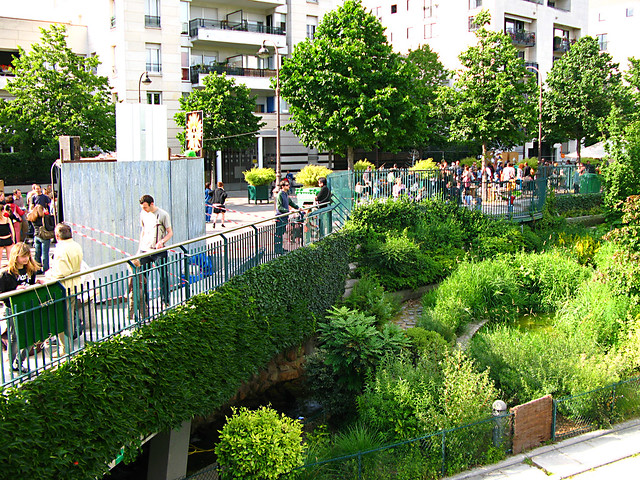Urban areas are a significant source of pollution entering streams, lakes, and rivers because of stormwater runoff produced by impermeable surfaces such as asphalt and concrete, which prevent water from being absorbed and naturally filtered. The conventional strategy for managing urban stormwater is through gray infrastructure, such as gutters, pipes, and basins. But today, many localities are using green infrastructure, conserving or mimicking natural spaces and processes to retain and infiltrate stormwater where it is generated. This improves water quality by reducing pollution loads.
 |
Green Streets is a stormwater management approach that improves water quality by incorporating green infrastructure into public rights-of-way. A number of forward-thinking localities are implementing Green Streets policies or similar mandates to integrate infrastructure every time they undertake a capital project or significant maintenance work in the existing public right-of-way. Over time, a substantial portion of their transportation corridors will be transformed into Green Streets. An important new target is the nation’s system of roadways, which create substantial water pollution because they are impermeable and coated with oil.
Green Streets can also save costs associated with gray infrastructure and reduce expenses on repaving and snowplowing. They can decrease flooding and combined-sewer overflows that release sewage into waterways. They can help local governments meet mandates under MS4 permits, CSO Long Term Control Plans, Total Maximum Daily Load implementation plans, and consent decrees.
ELI recently completed a study, funded by the Chesapeake Bay Trust, to determine best practices for local governments considering Green Streets policies. Our team examined 14 jurisdictions, analyzing how their policies are structured and implemented, and derived several key insights and related recommendations.
We found that successful implementation requires strong policies applied to a broad category of projects. Any exemptions should be clearly and narrowly defined. Sometimes reasons such as public safety, topography, historical sites, or fear of groundwater contamination argue against Green Streets. Further, when exempting Green Streets due to disproportionate cost, that term should be quantified — such as by a percentage of total project cost. This narrows agency discretion and prevents Green Streets from being inappropriately costed out of promising projects. We identified Central Falls, Rhode Island, as an example of a locality’s decisionmaking process for making exemptions that is transparent, well-documented, and subject to oversight.
Identifying a sustainable funding source is a must. The most reliable option for capital costs is an established stormwater utility, often leveraged to repay general obligation bonds. Nearly as critical is funding maintenance in order to ensure that Green Streets facilities are sustainable over the long term. Other sources may include gas taxes and regional transportation funding.
Portland, Oregon, developed another source of money, with its Percent for Green fund. All city-financed development, redevelopment, or enhancement projects that require a street opening permit or occur in the public right-of-way but don’t otherwise trigger the policy are assessed 1 percent of the construction costs, directed into the fund.
Localities should engage with the public as early as possible on projects and take a context-sensitive approach in design, looking at site conditions, neighborhood characteristics, and community values. This means being flexible and willing to adjust projects in order to obtain buy-in.
North St. Paul, Minnesota, learned this lesson early on, when residents rejected a pilot project. The city has since implemented three projects incorporating green elements under its Living Streets Plan.
Green Streets policies need to track implementation and resulting water quality improvement. Localities accomplish this through benchmarks and performance measures, conducting regular monitoring, and issuing annual reports.
Cities can leverage the resulting information to improve their policies. Kansas City, Missouri, reviews its policy every three years and Portland, which has over 10 years of experience, plans to update its policy based on lessons learned.
ELI synthesized its insights into a customizable model ordinance as a resource for local governments. Armed with this information, localities have the tools to green light their own Green Streets policies to restore regional watersheds while realizing further economic, social, and cultural benefits for their residents.
The study, Giving Green Streets the Green Light: Improving Water Quality Through Capital Improvement Policies, is available free for download at https://www.eli.org/research-report/giving-green-streets-green-light-improving-water-quality-through-capital-improvement-policies.
